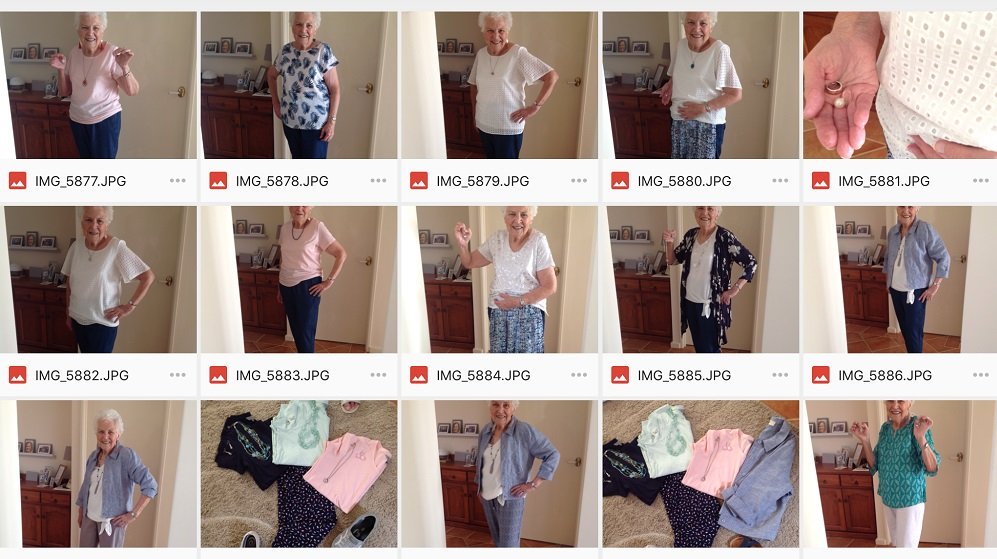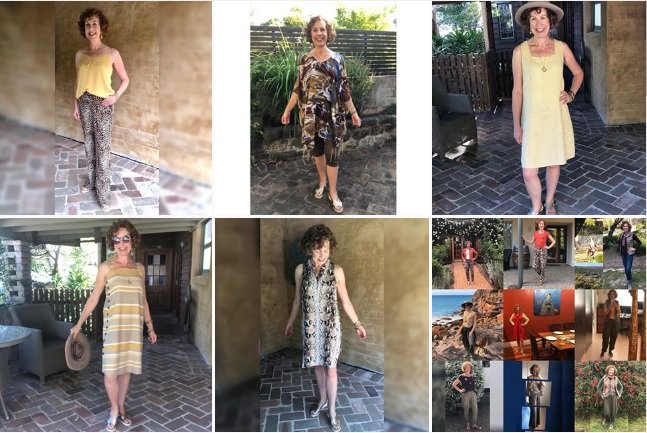Basic Wardrobe Planning
Wardrobe planning answers the question 'what should I have in my wardrobe?'.
Why plan your wardrobe?
Have you ever had an "I've got nothing to wear" moment? What did you do? Settle for wearing something that kinda, sorta worked, but didn't make you feel very comfortable or confident? Or perhaps you even made some sort of excuse and didn't go out at all? Either way, I suspect you felt pretty down on yourself!
Would you like to stop having those moments? When you know what you need in your wardrobe and how to plan it, you'll find you have something suitable to wear for every occasion.

One Benefit of Wardrobe Planning: something just right to wear for every occasion!
(an example from a wardrobe session with my lovely client Ruth)
Benefits of wardrobe planning include:
- Saving time deciding what to wear. Imagine having at least 1 or 2 outfits that work well for any event in your life!
- Saving money on wardrobe 'orphans' (items that don't go with anything else), and buying duplicates of items you already have
- More ease (less stress) by knowing you have something to wear for every occasion
Basic wardrobe planning steps
Before you start I recommend you audit and organize your wardrobe.
When you've done that, here are the basic planning steps. You'll find more detail below.
- Identify your wardrobe needs
- Review what you already have
- Create a shopping list
1. Identify your clothing needs
You'll find lots of articles telling you specific wardrobe essentials you need, such as a white shirt, and black pants, a little black dress and so on. However, I'm not a fan of generic lists like this!
What you need in your wardrobe depends on:
Your lifestyle -- what do you spend your time doing? Do you go out to work? Do you work from home? Are you a stay-at-home mum? Are you retired? What activities do you do? What special events do you have coming up?
Your environment -- what will the weather be like? How formal or casual do you need your clothes to be?
Your appearance -- what colors and shapes work for best for you?
Your preferences -- what are your likes and dislikes? What are your values? How do you want to express personality in your clothing? How many outfits do you want or need?
Do you understand the fundamental elements of style?
The fundamentals are understanding how to flatter your coloring, your proportions and your personality. I refer to these as your style criteria. It's so much easier to review your wardrobe, to buy clothes you like and to create outfits when you know your style criteria.
Learn more here: see steps 2, 3 and 4 in my 6 Steps to Savvy Style approach.
Pick a planning time period
It's easiest to plan for a specific time period. I recommend a 3 month or 6 month period. Wardrobe planning is easiest just before, or at the beginning of, a season, when it's natural to start thinking about updating your clothes. There's a full range of sizes in the shops earlier in the season too.
Mostly when I'm helping clients update their wardrobes we do this exercise twice a year for the main fashion seasons (that is Spring/Summer and Autumn/Winter). You may prefer to do your planning every 3 months, especially if you live somewhere with 4 very distinct seasons, which will mean 4 times a year: Spring, Summer, Autumn and Winter.
List your activities
Your wardrobe should reflect your lifestyle. For example: if you spend most of your time going out to work most of your wardrobe should contain clothes suitable to work in; if you're retired you need outfits suitable for the activities you do.
With your planning time period in mind, think about your lifestyle: What will you be spending your time doing? Do you have any special events coming up in that time?
Thinking about the roles you play in your life and the activities each of those roles entail might help you remember everything you do. If not, just list all the activities and events that are likely to come up within your planning period.
For example (roles are in bold below)...
Business woman -- if you spend most of your time going out to work most of your clothing should be suitable for work. Think about whether you need formal business attire or business casual or a mix of both. Activities requiring different levels of clothing might include: working at home, working in an office, meetings with clients, board meetings, staff meetings, entertaining...
- Mother -- if you spend most of your time running young kids around you mostly need comfortable casual wear. Activities might include: school run, PTA meetings, attending sporting events, and so on
Wife/partner -- activities might include those associated with domestic duties such as cooking, cleaning, shopping, gardening and so on as well as things you do together such as travelling, entertaining, socializing and so on.
Friend -- this might include socializing, sporting activities, walking, going out for coffee, lunches and dinners. Perhaps going to weddings, or funerals.
Self-carer! -- don't forget this role! What does this include for you: keeping fit, yoga, time alone, relaxing at home. List your activities
Determine your needs
For each activity and event in your list think about your clothing needs:
What formality level of clothing do you need for these activities? Casual, smart casual, semi-formal, formal, business casual, business formal?
How many outfits will you need for each area of your life and formality level?
Some activities will require the same style of clothing, and it may be possible to wear the same clothes for those activities. For example: you may require casual wear for home relaxing and running erands and be happy to use the same clothes for both areas; some of your more casual work clothes may double up as casual or smart casual going out clothes, or you may prefer to keep your work and non-work wear completely separate. Identify your needs. Also some basic wardrobe items such as camisoles, long sleeved tees, rain coats and so on, that you mainly use for layering, or as an outer layer, may work well across many formality levels.
2. Review what you already have
Look at the clothes you have in your wardrobe that are suitable for the time of year of your planning period. Now try on clothes and accessories and create outfits to fulfill needs on your planning list. It's important to plan whole outfits, so you don't sabotage an otherwise great outfit with the wrong accessory or outer layer. So remember to try shoes, jewellery, bags and outer layers as well.
Update your wardrobe plan every time you find you already have a suitable outfit in your wardrobe.
And make note of the outfits you like. A photo (selfie) is the easiest way to do this (it's also easier to be objective when you see your outfit in a photo, rather than you in the mirror). Then upload your outfit photos to a cloud drive, good free ones include Google Drive or Microsoft's One Drive. If you put the related app onto your smart phone or tablet device you'll easily be able to review your outfits to work out what to wear on a particular day. Or you might want to try one of the wardrobing apps that lets you create outfits in it, such as Stylebook (though so far I'm finding it too time consuming to take photos of wardrobe items in the format needed).
As you go through your wardrobe creating outfits you may find items that are nearing the end of their life, or an outfit that needs a different bottom, or top, or accessory. Start a shopping list by noting those items.
3. Create a shopping list
You now know the total number of outfits you need for all your likely activites and events over the next few months. You also know the outfits you already have in your wardrobe. And you know how many more outfits you need (or want). With this information you can continue to create your shopping wish list.
For example, you may want to create another 3 smart casual outfits with pants. Perhaps you already have 2 good pairs of pants, so add 1 more pair of pants to your shopping list and 1-3 tops that each go with at least 2 of the pants.
Identify priorities on your shopping list. For example, if you have a special event coming up and nothing already in your wardrobe then identify this as a high priority.
Keep your shopping list with you. I find it easiest to keep it as a note on my smart phone. That way, if you get an unexpected opportunity to shop you'll know the types of things you need to build out your wardrobe.
Finding inspiration for outfits
Need ideas for new ways to style your current clothes and accessories, and ideas for what clothes and accessories to buy? Here are some ideas of where to look:
- My article on mixing-and-matching your clothes
- My trend watch articles -- subscribe to my monthly newsletter to be notified of new articles
- Magazines -- fashion magazines and home magazines, online and printed
- Online fashion stores -- look for fashion websites of clothing lines you like and see if they have a newsletter or lookbook area
- Instagram -- follow the profiles of women whose style you admire. Use hash tags to search eg #over40style
- Pinterest -- you can search and follow people whose style you admire. You can also create your own style boards to collect ideas you like from around the web
- Street style -- your friends, other women you know, and women you see around you
Take notice of how outfits are styled, especially ones you like (and learn from those you don't like). Notice things such as: combinations of tops, bottoms, shoes etc; how are items in an outfit linked? by color, texture and so on; what styling techniques, such as tucking, are used?
Now you're ready to shop
However, this is perhaps not like any shopping you've done before. Now, you'll be shopping strategically. Using your shopping list you'll be building and maintaining your wardrobe to ensure it's an inspirational place to be! Find out more here
Like This Page?


Comments
Have your say about what you just read! Leave me a comment in the box below.